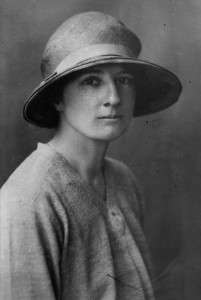Ina Boyle
Ina Boyle (8 March 1889 – 10 March 1967) was an Irish composer: the most prolific and significant female composer from Ireland before 1950.[1] Her compositions encompass a broad spectrum of genres and include choral, chamber and orchestral works as well as opera, ballet and vocal music. While a number of her works, namely, The Magic Harp (1919), Colin Clout (1921), Gaelic Hymns (1923–24), Glencree (1924-27) and Wildgeese (1942), received acknowledgement and repeated performance during her lifetime, the majority of her compositions remain unpublished and unperformed.[2]

Biography
Boyle was born in Bushey Park near Enniskerry and grew up in a restricted circle of her mother, father and sister. Her first music lessons were with her father William Foster Boyle (1860–1951), who was curate at St. Patrick’s Church, Powerscourt and was given violin and cello lessons by her governess with her younger sister Phyllis. From the age of eleven, she studied theory and harmony with Samuel Myerscough. From 1904 onwards, she also undertook lessons via correspondence with Charles Wood, who was married to Boyle’s cousin Charlotte Georgina Wills-Sandford. In 1910, Boyle began to take lessons with Percy Buck who had just been appointed a non-resident professor of music at Trinity College Dublin. By 1913, Boyle began studying counterpoint, harmony and composition with Charles Herbert Kitson and George Hewson in Dublin.[3] From 1923, Boyle began to travel to London to take lessons with Ralph Vaughan Williams. After exchanging correspondence, Boyle took her first composition lesson with Vaughan Williams at his home in February 1923.[4]
Because of her isolation, Boyle's music was seldom performed. However, she continued to compose until her death.[5] Rob Barnett has pointed out that the brief, three movement Violin Concerto of the early 1930s "has more in common with The Lark Ascending than with the big British Isles statements (Bax, Walton, Dyson, Creith and Moeran) of that decade".[6] The Concerto was dedicated to Boyle's mother who had died in 1932. Her composition The Magic Harp received a Carnegie Award, and she won an Olympic Honorable Mention in 1948 for Ireland with Lament for Bion, a composition she submitted to the Olympic Cultural Activities Committee.[7] She died of cancer in Greystones, County Wicklow,[8] and her papers are archived in the Library of Trinity College, Dublin.[9] Trinity College has digitised most of her music manuscripts, and they can be searched and studied online.
A feature-length documentary about the life and music of Ina Boyle titled From the Darkness was broadcast 12 June 2010 on Ireland's RTÉ Lyric FM. In April and May 2013, an exhibition at Trinity College highlighted "Ina Boyle’s Symphonic Journey".
Selected works
|
Opera
Choral music
Orchestra
Voices with orchestra
|
Songs (for voice and piano, if not otherwise mentioned)
Ballet scores
Chamber music
|
Recordings
- The Magic Harp, performed by Bournemouth Symphony Orchestra, Ronald Corp (cond.), on: Dutton Epoch CDLX 7276 (CD, 2011).
- The Wild Geese, performed by European Union Youth Orchestra, Laurent Pillot (cond.), on: Classical Recording Company CRC 2309 (CD, 2013).
- Sleep Song and Three Songs by Walter de la Mare, performed by Aylish Kerrigan (mezzo) and Dearbhla Collins (piano), on: Métier MSV 28558 (CD, 2016).
- Elegy, performed by Nadège Rochat (cello), Staatskapelle Weimar, Paul Meyer (cond.), on: Ars Produktion ARS 38 221 (CD, 2017).
- Orchestral works: Overture; Violin Concerto; Symphony No. 1 Glencree; Wildgeese; Psalm; A Sea Poem; Colin Clout, performed by BBC Concert Orchestra, Benjamin Baker (violin), Nadège Rochat (cello), Ronald Corp (cond.), on: Dutton Epoch CDLX 7352 (CD, 2018).
Bibliography
- Elizabeth Maconchy: Ina Boyle. An Appreciation with a Select List of Her Music (Dublin: Dolmen Press, 1974).
- Sheila Powerscourt: Powerscourt and Ina Boyle, in: S. Powerscourt: Sun too Fast (London: Bles, 1974), pp. 201–15.
- Axel Klein: Die Musik Irlands im 20. Jahrhundert (Hildesheim: Georg Olms Verlag, 1996), pp. 174–6, 368–71.
- Sonya Keogh: Ina Boyle. A Life and Work (MPhil, University College Cork, 2002).
- David Scott: Examining the Irish Art Song: Original Song Settings of Irish Texts by Irish Composers, 1900–1930 (MPhil, DIT, 2018).
- Ita Beausang, Séamas de Barra: Ina Boyle (1889–1967). A Composer's Life (Cork: Cork University Press, 2018); ISBN 9781782052647.
References
- Sadie, Julie Anne; Samuel, Rhian (1994). The Norton/Grove dictionary of women composers (Digitized online by GoogleBooks)
|format=requires|url=(help). - https://www.cmc.ie/composers/ina-boyle
- Scott, David (2018). Examining the Irish Art Song: Original Song Settings of Irish Texts by Irish Composers, 1900-1930 (MPhil). DIT. pp. 109–110.
- Vaughan Williams, Ralph; Cobbe, Hugh (2008). Letters of Ralph Vaughan Williams 1895-1958.
- Fuller, Sophie (1994). The Pandora Guide to Women Composers: Britain and the United States.
- Boyle: Orchestral Works. MusicWeb International
- "COMPÉTITIONS D'ART" (PDF). Retrieved 1 February 2011.
- Ita Beausang: "Boyle, Ina", in: The Encyclopaedia of Music in Ireland, ed. by Harry White and Barra Boydell (Dublin: UCD Press, 2013), p. 119–121.
- "INA BOYLE (1889-1967)". Archived from the original on 20 October 2006. Retrieved 1 February 2011.